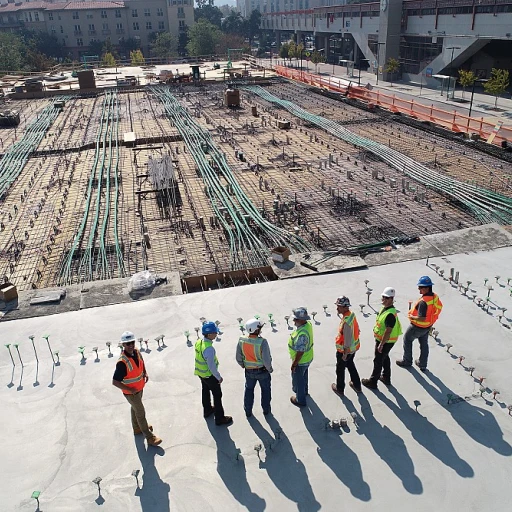The Rise of Automation and Its Impact on Jobs
A New Industrial Revolution
The world of work is undergoing a transformation that many experts are calling the fourth industrial revolution, driven by the rapid proliferation of automation technologies. As these advancements continue to evolve, they hold the promise of reshaping industries and altering the employment landscape in ways that were once unimaginable. From sophisticated algorithms to self-guiding robots, automation is no longer a distant possibility but rather an integral part of modern workplaces.
As we step deeper into this era of unprecedented technological progress, it's becoming increasingly evident that automation is having both immediate and long-term effects on job markets. On one hand, it boosts productivity and operational efficiency, while on the other hand, it raises questions about the future of employment as machines take over more routine and repetitive tasks.
The concern often voiced is whether automation will lead to massive job losses, creating a scene reminiscent of past industrial upheavals. However, history suggests that while new technologies often displace certain types of work, they also create new opportunities, professions, and demands for different skill sets. This dichotomy highlights the importance of approaching the integration of automation with careful planning and proactive strategies.
In particular, the intersection of automation and employment demands a keen focus on how these technologies can be harnessed to complement human capabilities rather than replace them. Understanding how automation is currently influencing job roles and sectors will help us navigate this transition more effectively. For a deeper dive into the implications of job automation, you can explore
this comprehensive analysis on the future of job automation.
Looking at the bigger picture, it's not just about machines taking over tasks; it's about how we can prepare ourselves for a future where humans and machines work together in synergy. As we explore the skills that will be in demand and discuss strategies for workforce adaptation, it becomes clear that the human touch will continue to play a crucial role in areas where creativity, emotional intelligence, and complex problem-solving are indispensable. The journey into this automated future invites us to rethink, reshape, and reinvent how we perceive work, forging a path that balances technological advancement with the invaluable insights that only humans can provide.
Skills for the Future: What Workers Will Need
Essential Skill Sets for Tomorrow's Workforce
As the world of work evolves with ever-increasing automation, it's crucial for workers to adapt to remain relevant in the job market. With machines taking over repetitive and predictable tasks, the demand for skills focusing on creativity, critical thinking, and emotional intelligence is on the rise.
One of the most significant areas workers will need to focus on is digital literacy. This extends beyond basic computer skills to encompass understanding digital processes, data analysis, and the ability to leverage technology in innovative ways. Being digitally savvy not only enhances one's competitiveness but is often a prerequisite for the jobs of tomorrow.
Moreover, problem-solving and critical thinking abilities remain indispensable as businesses strive for solutions that machines alone cannot provide. The ability to analyze situations, think logically, and make reasoned decisions will set workers apart in an increasingly automated environment.
Creativity and innovation will also serve as pivotal skill sets, fueling business growth and product development where machines hit their limitations. In a world where an increasing number of tasks can be performed by robots, human ingenuity is invaluable.
Lastly, as automation reshapes many industries, adaptability becomes a critical asset. Workers who are open to continuous learning and can pivot to new roles will have a marked advantage in a dynamic job landscape.
For those interested in a deeper dive into how these skills will shape employment prospects, consider exploring the
future of job automation. Understanding this transformation is key to thriving in the future job market.
Automation's Role in Economic Growth
The Catalyst for Economic Advancements
The integration of automation into countless industries has been a significant catalyst for economic advancements. By optimizing efficiency and streamlining processes, automation has allowed businesses to reallocate resources, reduce costs, and essentially redefine productivity. This, in turn, has opened up new avenues for economic growth that were previously unattainable.
A critical aspect to consider is the potential for automation to not only replace mundane and repetitive tasks but also to create new ones. This transformation presents challenges as well as opportunities for both companies and workers. As businesses implement these advanced technologies, they can focus on innovation and the development of new markets, contributing to overall economic expansion.
Moreover, the ripple effects of automation extend beyond individual companies, impacting whole industries and the global economy. Faster production times, enhanced supply chain management, and the capacity for personalized goods are just a few examples of how automation can spur economic growth by meeting evolving consumer demands.
Incorporating automation gives industries the opportunity to diversify revenue streams and develop business models that leverage both human and machine capabilities. However, this requires strategic planning and investment in workforce transitions, as discussed earlier. Retraining programs and the development of skills for the future workforce are crucial to ensure that the economic benefits of automation are realized fully.
For further insights into how automation is reshaping the future dynamics of workplaces, you can explore more at
the future of the modern office.
As automation continues to evolve, it remains a powerful tool for driving economic advancements. The challenge and opportunity lie in balancing these advancements with the necessary human skills and innovation, resulting in a resilient and prosperous future for both industries and their workforces.
The Human Touch: Where Machines Can't Compete
Striking a Chord: The Unique Value of Human Abilities
In an era where machines increasingly handle repetitive and data-driven tasks, one might wonder what remains for the human workforce. The answer lies in our unparalleled ability to connect, create, and empathize. While automation is transforming industries and reshaping the workforce landscape, certain intrinsic human qualities continue to hold unparalleled value.
Firstly, let's talk about creativity. Machines can analyze and process existing data, but they lack the ability to craft novel ideas without human intervention. Creative thinking, which includes activities like designing, storytelling, and innovating, remains firmly in the human domain. This brings a significant opportunity for those who harness their creative potential in the workplace.
Emotional intelligence is another area where machines fall short. The capacity to understand and manage interpersonal relationships with empathy is a fundamental human trait that cannot be replicated by algorithms. This skill is increasingly valuable in roles that require collaboration, negotiation, and leadership.
Problem-solving is also an area where humans currently outshine machines. The ability to combine creativity, critical thinking, and a nuanced understanding of human emotion allows individuals to devise solutions to complex issues that automated systems might find perplexing.
Then there’s adaptability. While technology can be programmed for specific tasks, humans possess the remarkable ability to adjust to new circumstances, learn new skills, and adopt new mindsets, making them indispensable in rapidly evolving work environments.
In preparing for workforce transitions and the future workplace, embracing and enhancing these unique human skills will be crucial. Workers and organizations need to invest in developing these traits to ensure they remain competitive in a progressively automated world.
Therefore, while technology enables efficiency, improvement, and growth, the inherent human touch will always serve as the distinguishing factor that enriches the workplace and drives leadership, innovation, and successful collaborations.
Preparing for Workforce Transitions
Embracing Change: Adapting to a New Job Landscape
As industries continue to experience the ripple effects of automation, the need to adapt to a transforming job market becomes apparent. The evolution described in previous sections shows how automation is reshaping employment opportunities and underscores the necessity for workers to evolve alongside these technological advancements.
The emergence of automation is not just a challenge; it's an opportunity for growth and innovation. Workers must recognize the importance of continuous learning and the development of new skills that align with the tech-driven future. Employers, too, must take proactive steps in facilitating transitions within their workforce. This involves offering training programs and resources tailored to equip employees with both technical skills and soft skills, such as critical thinking and creativity, which remain beyond the reach of machines.
Moreover, cross-discipline collaboration between industries and educational institutions is crucial. Implementing apprenticeship models and partnerships can ensure that the workforce receives practical, hands-on experience that aligns with the latest technological demands. These approaches not only provide a lifeline to those whose roles are at risk but also cultivate a broader talent pool ready to thrive in a hyper-automated environment.
Finally, fostering a culture of adaptability within organizations can ease workforce transitions. Cultivating an agile approach to change management, where both employers and employees view transitions as natural and necessary progressions, will be instrumental in navigating the future of work.
By recognizing and addressing these needs, societies can mitigate potential disruptions and create a more resilient workforce capable of thriving in an automated world.
The Symbiosis of Automation and Human Effort in Tomorrow's Workspace
As we gaze into the future of the workplace, the narrative is no longer 'man versus machine' but rather 'man working alongside machine'. Throughout our exploration, we've established how automation is reshaping the landscape of employment, influencing everything from the types of jobs available to the skills that will be in demand. Now, we turn our attention to the delicate balance that will define future work environments—melding the precision and efficiency of automation with the irreplaceable ingenuity and empathy of human input.
In this new dynamic, jobs will not disappear; they will evolve. The emphasis will be on creating roles that maximize the strengths of both humans and machines. For example, machines excel at handling repetitive tasks that require speed and accuracy, freeing human workers to focus on more strategic, creative, or interpersonal aspects that machines aren't equipped to handle. This pivot requires a paradigm shift in how organizations structure their work processes.
Employers must craft an environment that fosters collaboration between humans and machines. Designing workflows that integrate automation not only enhances efficiency but also supports human innovation, providing employees with opportunities for growth and adaptation. Such an integrated approach will encourage job roles to become more enriching, allowing for creativity and critical thinking—skills that are increasingly essential in the modern workplace.
Moreover, workplaces will need to develop flexible cultures that embrace change and continuous learning. As highlighted previously, the skills required in future jobs will lean heavily on adaptability, problem-solving, and emotional intelligence. Organizations that encourage these skill sets can remain competitive as technological advances continue to accelerate.
Ultimately, the future workplace will be defined by how well it can balance the contributions of machines with the unique attributes of human workers. By harnessing the strengths of both, businesses can drive innovation and growth, positioning themselves for success in an automated world. The journey towards such harmonious integration might be challenging, yet it promises a more dynamic and fulfilling work experience for all.













